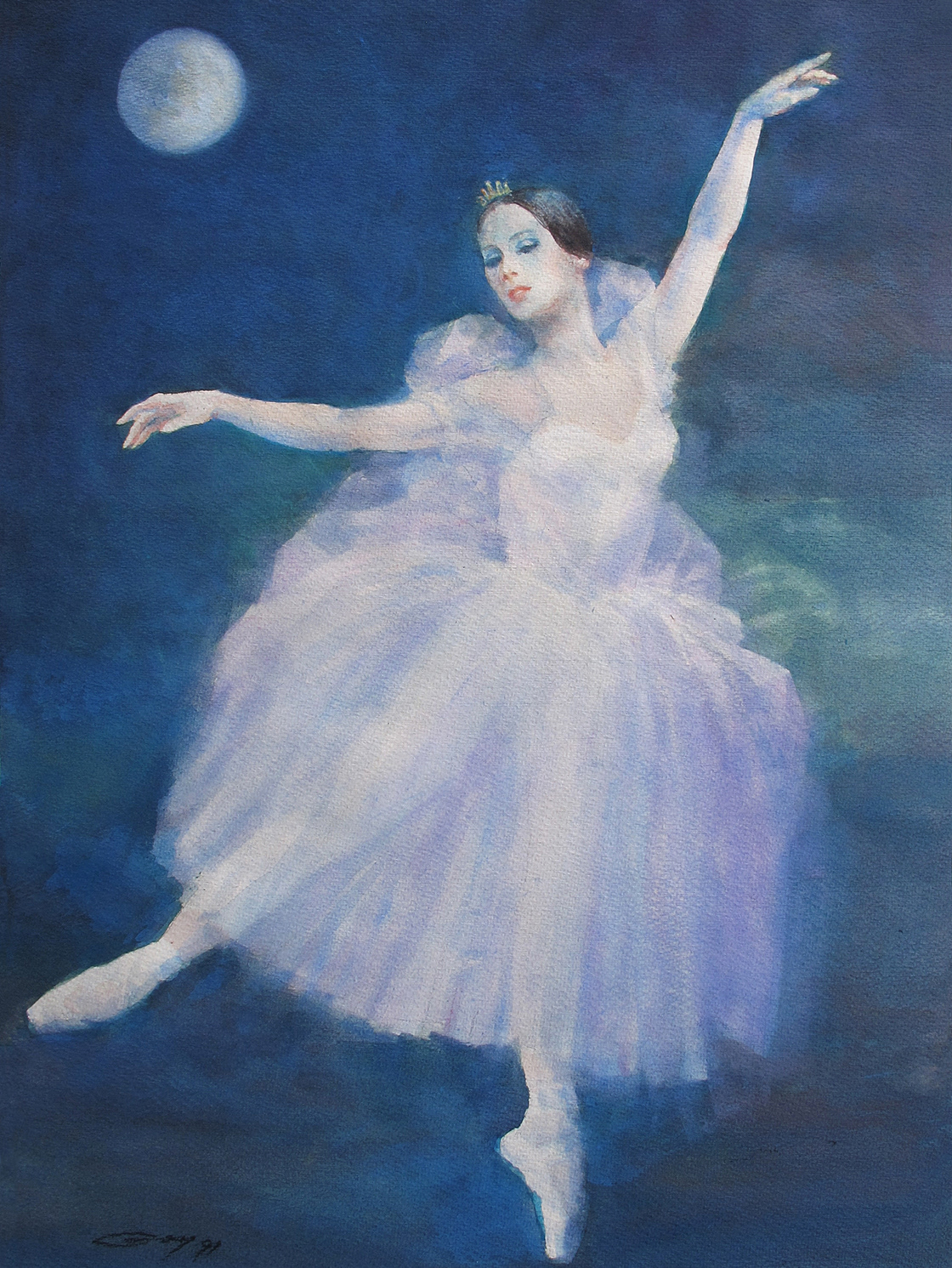Jessica Jalandoni-Robillos
04 October 2014, Malate, Manila
A pairing of two disciplines heralds the understated mastery of Agustin Goy as his brushstrokes echo the stringent demands of classical ballet. Painting ballerinas and the occasional danseur has Goy constantly executing his own pas de deux with Terpsichore as his partner, the dance of his hands the fruition of and testament to classicist instruction that harks back to his childhood. Preceding his ability to read, the artist had already a keen fondness of classical melodies and pouring over images on books. Apparent even then was his creative response to the aural and the visual, their combination inevitably instilling in him a deep appreciation for ballet theater.
The ballet is a venue where Goy the artist enjoys the challenge of the female-- particularly the grace and fluidity of a woman’s figure which are underscored by the movements in classical dance. This attention to figures perhaps also points to the architect in Goy, since the ballerina’s embodiment of strength, perfect form, and aesthetic projection may easily fulfill the Vitruvian requirements of “firmatis, utilitas, venustatis (durability, utility, beauty)” in classical architecture canon.
That beauty is the function of coupled form and strength seems the logic behind Goy’s insistence on depicting many a balletomane’s delight. Driven, too, by the classical musical accompaniment that the painter also deems as expression of a truly pure kind, his series of ballet dancers in full performance regalia conveys the details of his highly respected artistry.
From the dance artists’ gleaming satin pointe shoes, the stiffly shirred tulle tutus or softly flowing chiffon skirts and fitted bodices to the impeccable bun-topped coifs often accented by sparkling tiaras, these costumes serve very well as messengers of
Goy’s expertise. Rendering the various layers or pieces of the dancer’s garb entails deft handling of the paintbrush. To indeed achieve the same gradient of opacity to translucence, whether with the use of oil paint, pastel, or a water-based medium is proof of his prowess--for while oil can be quite reticent when it comes to transparency, watercolor could also be loathe to endow opaqueness.
The play of light via differing levels of transparency is heightened by the soft focus treatment applied deftly by the artist as he includes the classicist staple of the repose not surprisingly in “Au Repose” and “A Terre.”
The adroit conveyance of light further comes into play not only with the brilliant gradations of brightness from shiny costumery and the darkening of the ground against the figures but more so when the dancer’s tensile power must be shown despite the diaphanous dress that partially obscures the view of her limb on pointe as in “En L’aire” and the legs in “Les Ailes.”
Inner garments are seen beneath the shadowing of skirting fabric and a hand bent inwards, toward the body at the specifically prescribed angle is visible too, through the tutu fronds in “Allegro.’’ Notably exquisite hands are present in Goy’s ballet ouvre and it is out of faithfulness to his chosen muse that he strives to impress upon viewers the inclusion of exact extremities positioning.
In “Allegro” again emerges the merging of the architectural training of Goy, the life drawing lessons from no less than Vicente Manansala, and his admiration for the structural marvel that is the dancing ballerina. Here is perfectly shown how the dancer maintains precise posture and balance with a line she must imagine running from the middle of the top of her head, through her ramrod-straight back and down to the tip of her pointe ballet shoe. This certainly is fine figure rendition with didactic function. A plumb-bob may actually be hung against the piece and it would run from the top of the painting, to atop the subject’s neck, through the length of her spine, to the spot on which she tiptoes. The resulting plumbline demarcates the work into two absolutely straight vertical ractangles while it goes right through the center of gravity and proves the correct alignment of the vertebra and the one supporting leg.
A mimesis of sorts stands at the core of Agustin Goy’s romance with ballet. The glide of his strokes seems to mimic the complex motions of the ballerina who moves with a soft grace that belies hard strength; can leap as if to fly and land weightless but is propelled by sinewed agility and is pliantly elegant but capable of rigid power. Thus it is a mimetic circle whereby Goy is creatively driven by the perfected form achieved with technical precision in classical ballet, and it is Goy’s expert rendition and technique that revere the female form.
Among the works featured, it is perhaps “Adagio” that is somehow a balletic translation of Goy’s esteemed status in the industry. As the artwork’s title implies, the ballerina maintains her gentle yet powerful steps to a mild tempo just as Goy’s career may be defined as one that strongly endures through a relaxed measure of time.
